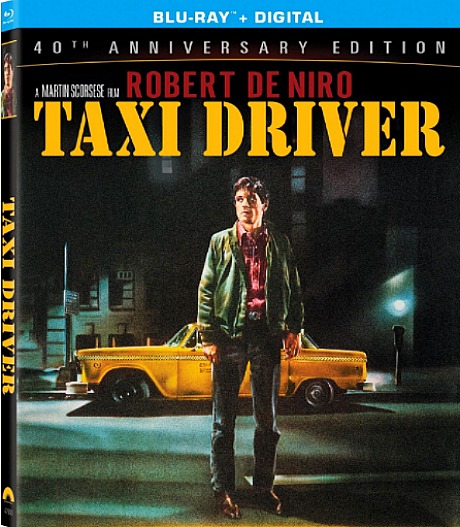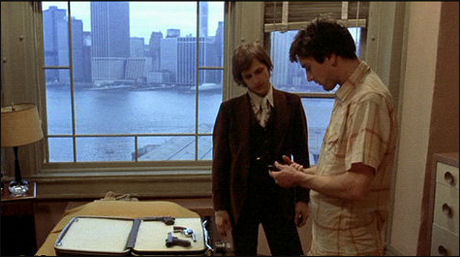Somebody asked for my feelings about Sony’s recently-popped 40th anniversary Bluray of Taxi Driver. Seven words: “No, thanks, not even for $9 dollars.” I own the 4K Bluray that came out in 2011, and that’s about as good as it gets. Qualifier: If Scorsese ever comes to his senses and approves a re-coloring of the Lower East Side shoot-out sequence the way it looked before the MPAA demanded changes because of all the blood, which led to Scorsese diminishing this sequence with a desaturated brownish tint…if Scorsese decides to release the original red-blood version of Taxi Driver, the one he was happy with before he was told to change it, fine — I’ll buy that. But until then, naah.

Posted on 3.11.11: Yesterday Digital Bits editor Bill Hunt posted a discussion with respected Sony restoration guy Grover Crisp about the forthcoming Taxi Driver Bluray (due on 4.5.), which represents a serious restoration effort on Crisp’s part, especially given the input from director Martin Scorsese.
I was naturally most interested in Crisp’s explanation of the sepia-toned/brown blood shoot-out sequence at the finale. As I put it two months ago, “There can be no legitimate claim of Taxi Driver having been restored without the original natural color (or at least a simulation of same) put back in. The film was shot with more or less natural colors, was intended to be shown this way, and has in fact been shown that way for the last 35 years except for the final shoot-out scene. There’s nothing noble or sacred about the look of that final sequence. The fact that it was sepia-toned to get a more acceptable MPAA rating is, I feel, a stain upon the film’s legacy.”

Hunt asks Crisp “why didn’t you restore it to the originally-shot, more colorful scene?” Crisp answers as follows:
“There are a couple of answers to this. One, which we discussed, was the goal of presenting the film as it was released, which is the version everyone basically knows. This comes up every now and then, but the director feels it best to leave the film as it is. That decision is fine with me.”
Wrong! Scorsese’s repeated statements that he’s against showing the film as originally shot and processed and his defending the brown-sepia tones as being part of the ’70s and the climate when the film was released is one of the most surreal, reality-divorced declarations on the part of a major director in motion picture history. I realize there’s no political upside in Crisp echoing this viewpoint, but for any restoration guy to say he’s “fine” with maintaining the look of a film that was altered due to ratings-board censorship is coming from a very curious place, in my opinion.
Crisp goes on to say that “there is an impression from some who think we could easily ‘pump’ the color back into that scene, and that is not as easy as it sounds.” I’m sure he’s right, but note that he doesn’t say it’s impossible. And yet his explanation of the technical particulars does seem to indicate that bringing the shoot-out finale back to real color would be next-to-hopeless.
“The film was not just printed darker, or with muted colors, as some think,” Crisp explains. “There are two sections of the original negative that were removed from the cut and assembled camera negative. One is the long shot where the cab pulls up, Bickle walks over to Sport, they argue, he shoots him, then he walks back and sits on a stoop. That is all one shot that was removed. The second section removed begins with the shot of the interior of the apartment building where he shoots the hood in the hand and all the shots following this down to the final one of the overhead crowd shot outside — that entire sequence was removed as assembled. These two sections of original camera negative were then sent to TVC, a small lab in New York, where it went through a Chemtone process, a chemical treatment that somewhat opens shadows allowing for greater density and lower contrast, for the most part. The exact process was a bit clouded by TVC as a proprietary service, but it usually involved original processing and, at this point, the negative was already finished.
“Whatever the actual processes, what I can say is that they delivered back duplicate negatives of these two sections, with the long sequence, in effect, now an optical dupe and with the desired color and density built into it. So, literally, when printing this film at a lab then (or now), there was no way to grade it and print it the way it was shot. Those muted colors are built into the dupe negative and it doesn’t work to try to print it otherwise. We also searched many times over the years for the original negative that was removed, but to no avail. Likely, it was junked at TVC at the time.”
Posted on 8.12.07: This is a fairly old gripe, but with the release of the new Taxi Driver special edition double-disc DVD on 8.14 it seems allowable to dredge it up again. It’s addresses the core definition of the term” original vision” so it’s a fairly major issue.

When this 1976 film was restored sometime around ’96 or ’97, director Martin Scorsese made the decision to leave the brownish sepia tint over the final shoot- out scene in that lower East Side tenement building, even though it wasn’t part of his original vision to have it look this way. Scorsese was forced into the brown-tint alternative (i.e., which toned down the red-blood shots) by the ratings board, and his explanation for keeping this muted color scheme is that “this is how the film looked when it came out…this is what it was, a product of the time we were living in, the forces we were dealing with.”
The brownish tint obviously had nothing to do visually, thematically or conceptually with the rest of the film — it was a political solution enforced by persons who had nothing to do with Taxi Driver until it was in post — and it obviously separates this sequence from the rest of the film. (It looks just as jarring and strange today as it did back then.) In this sense Taxi Driver is very much a co-directed film, and obviously not to anyone’s credit. .
And yet Scorsese, a cineaste extraordinaire who’s fought for the restoration of classic films all his life, wants it to stay brownish for a reason that no other artist in any medium has ever used. He’s the only movie director in world history to not only accept but defend the vandalizing of one of his own works….amazing
Imagine Leonardo Da Vinci‘s “Mona Lisa” hanging today in the Louvre with a big grayish smear across the lower right side of the painting because one of Da Vinci’s assistants happened to spill a jar of paste as he was framing it way back when. And Louvre restorationists haven’t cleaned it off because Da Vinci’s estate, wanting to respect the conditions under which he created this legendary work, has made it clear that he wanted it left alone. How would this differ from what Scorsese is saying? God’s lonely man indeed.
